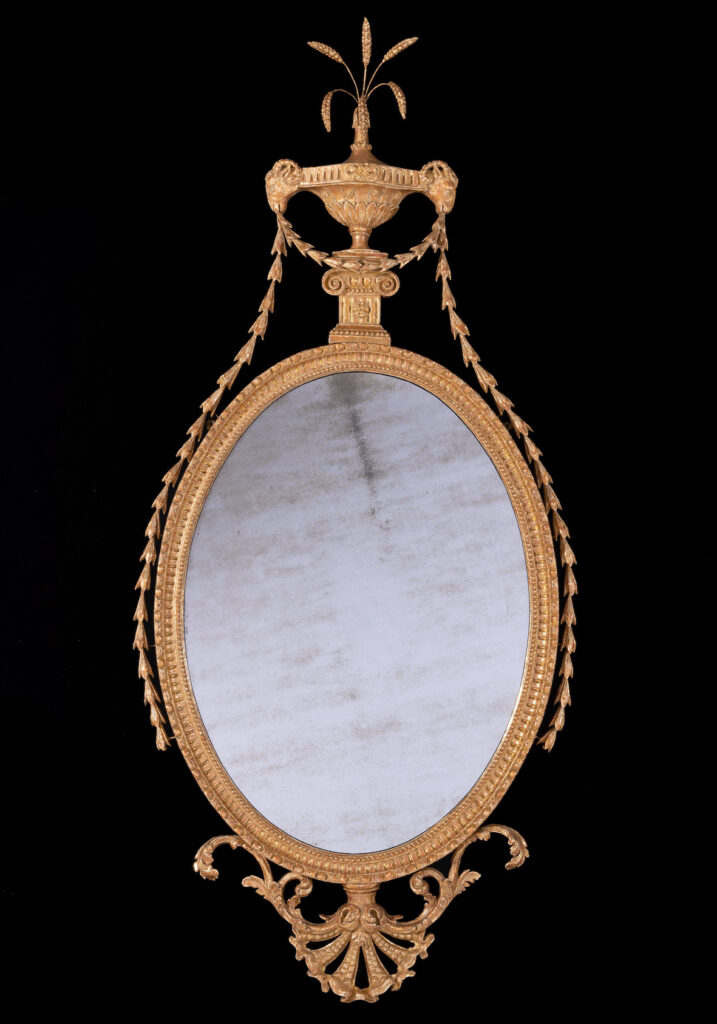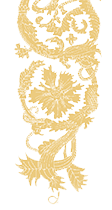George III John Linnell Oval Mirror

George III John Linnell Oval Mirror
English
circa 1770 - 1780
Fine George III 18th century period carved giltwood oval mirror attributed to John Linnell.
The carved and well drawn oval medallion mirror with pearled and reed-gadrooned borders and a beaded slip, is below a surmounted carved urn with protruding wheat sheaf. The crisply carved swaggered urn has a fluted border centralised bow and flanked by ram-masks, issuing husk trails. The urn is supported on an 'Ionic' scrolled and fluted capital pedestal adorned with a shell and a beaded base. The trailing husks that flank the mirror are complemented with a vase-capped medallion apron with a pearled framed border and six carved flowered patterae.
A vase-capped medallion frame with pearled border framed by six flowered patterae features on a design by John Linnell, dated 1774 (H. Hayward and P. Kirkham, William and John Linnell, London, 1980, vol. II, fig. 196).
A mirror with an identical carved apron was supplied to Sir Penistone Lamb, 1st Viscount Melbourne (1748-1819) for Brocket Hall, Hertfordshire, or Melbourne House, Piccadilly, London. Possibly by descent to Admiral of the Fleet Lord Walter Kerr, G. C. B., Brocket Hall, Hertfordshire, sold Mssrs. Foster house sale, 9 March 1923, lot 944, 'An oval mirror, in carved and gilt frame, 26 in. wide'. Possibly acquired at that sale by Sir Charles Nall-Cain, Bt., 1st Lord Brocket (d. 1934) and by descent.
A closely related but pair of mirrors, with additional husk festoons draped from the rams' mouths and eight rather than six paterae, was exhibited by Edward Nield at the Antique Dealer's Fair, 1963 and advertised by Old Clock House in The Connoisseur, June 1966. These also have a finial with pineapple and palm-like foliate.
Condition
Excellent original plate and a good scale frame
Literature
The Linnell firm was created in 1730 by William Linnell (1703 -1763) and was inherited by his eldest son (some say his nephew) John (1729 - 1796) in 1763. They were both prominent 18th century cabinet-makers, designers, upholders and carvers.
The firm was one of London's largest and most renowned cabinet-making firms creating grand carved and gilded furniture for many important and prominent patrons. They made commissions for a number of important country houses including Badminton House, Osterley Park, Syon Park, Alnwick Castle, Shardeloes, Bowood House, Methley Hall and Lansdowne House.
As a young boy, John’s talent as an artist must have been evident to William who sent him to study at St Martin’s Lane Academy. There he found himself among an international group of teachers and students studying Rococo design, particularly by French exponents of the style. He became the firm’s designer both of interiors and furniture and enjoyed painting in water colour for his own pleasure.
The firm moved from 8 Long Acre, St. Martin's Lane, to the West End of London at 28 Berkeley Square in 1754. In the same block in Martin’s Lane had been Cobb, Vile, Hallett and Chippendale.
One of John Linnell's first jobs as a designer in his father's firm was for a suite of furniture for Charles Somerset, 4th Duke of Beaufort's Chinese bedroom at Badminton House.
In 1762 John started working closely with Robert Adam and on William’s death in 1763, John found himself in sole charge of the company. These two combining factors pushed his work in a new classical direction. His many and varied works rivalled those of other leading furniture makers such as Thomas Chippendale, Mayhew and Ince, Robert Adam and John Cobb for aesthetic beauty and taste. Most importantly it was the re-introduction of marquetry into English furniture manufacture that William, and more importantly John, championed and that they felt revived the neo-classical ideals.
The firm employed some 40 or 50 people and many of its clients continued to patronise John Linnell, including William Drake of Shardeloes, Lord Scarsdale and Francis Child, all of whom also employed Robert Adam, after William’s death.
Much of his work between 1750 and 1760 reveals his mastery of the Rococo style, using idioms adapted from contemporary French engraved designs. Some introduce Chinoiserie and Gothic features. He also became interested in engraving designs for silverware such as coffee pots, jugs and carved girandoles. Amongst his furniture designs were two enormous carved and gilt sofas for Lord Scarsdale at Kedleston Hall, Derbyshire and library furniture for Robert Child at Osterley Park. William Kent seems to have been a major source of inspiration to him. By 1765 he had mastered Neo-classical form and ornament, partly as a result of contact with Robert Adam.
Linnell submitted designs for the State Coach of George III. Several designs were submitted for this important commission. It is thought that Robert Adam also submitted designs. It was the King's architect William Chambers, who produced the final chosen design.
Linnell was also involved in the design of the Drury Lane theatre. He produced the designs for the boxes, under the direction of Henry Holland. Some of his work and many of his designs now survive at the V&A.
Shortly after the Drury Lane theatre work in 1794 he rented a house in Bath as his health was not good. He subsequently moved to Notting Hill Gate where he died in 1796, almost bankrupt.
Features typical of John Linnell’s work include masterful carving, leitmotifs such as symmetrical c-scrolls, miniature urns, flowering baskets, scrolling acanthus, husk swags and lovers’ bows which are all unified in the mature design of this great master.
He had an unconventional lifestyle, by all accounts, and there is no record that he ever married but in his will he bequeathed two hundred pounds to Ann Gale, daughter of Ann Gale. This is thought to have been an illegitimate daughter, and her mother to have been his long term mistress.
The fate of the firm after his death is uncertain.
There is speculation that in the last years of his life John Linnell entered a partnership with his relative Thomas Tatham (1763–1817), however the evidence is not conclusive. Thomas Tatham went on to be a partner at one of London's fashionable cabinet-making and upholstery businesses with George Elward, Edward Bailey and Richard Saunders. They were principal cabinet-makers to George IV and this firm worked at Carlton House and Buckingham Palace.
Thomas Tatham and his brother Charles Heathcote Tatham were trained in drawing and design by John Linnell. Linnell introduced Tatham to Henry Holland who later funded his educational trip to Rome. In 1796 when Tatham learned of Linnell's death, he was in Rome and wrote to Henry Holland, who had his home in Sloane Avenue, Knightsbridge, that he was deeply upset by John Linnell's death. Upon his return to London he compiled a selection of 355 of John Linnell's drawings and designs, which his brother Thomas Tatham had inherited. These drawings now survive at the V&A.
Dimensions
Height 145.00cm (57.09 inches)
Width 68.50cm (26.97 inches)
Depth 3.00cm (1.18 inches)
Stock No: 11312
Sold


